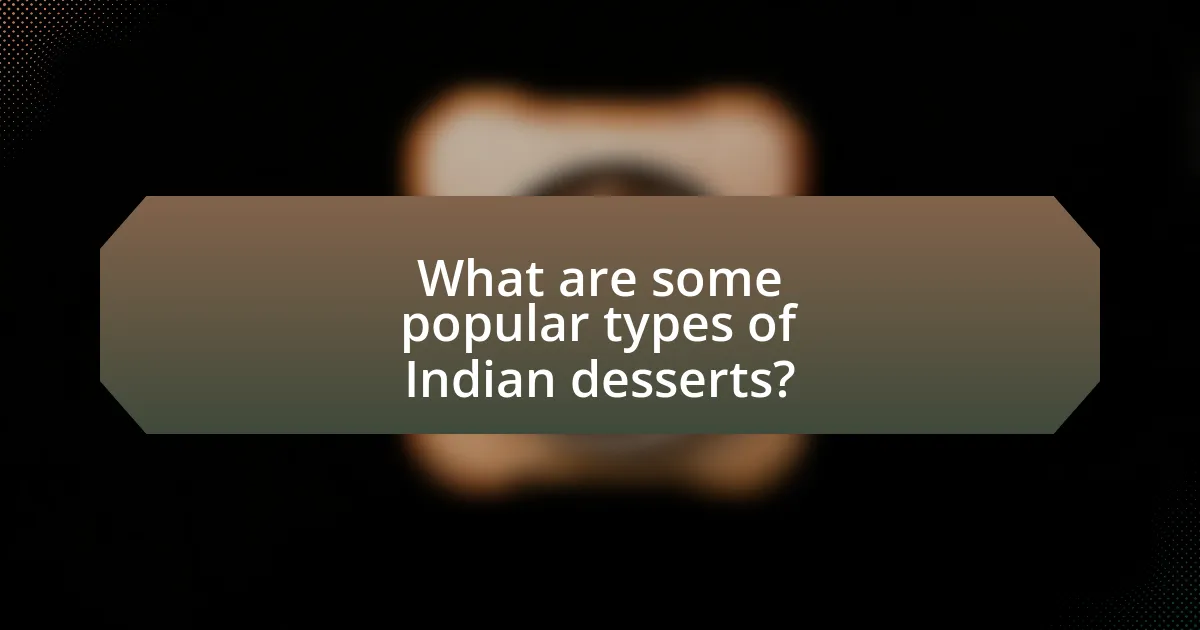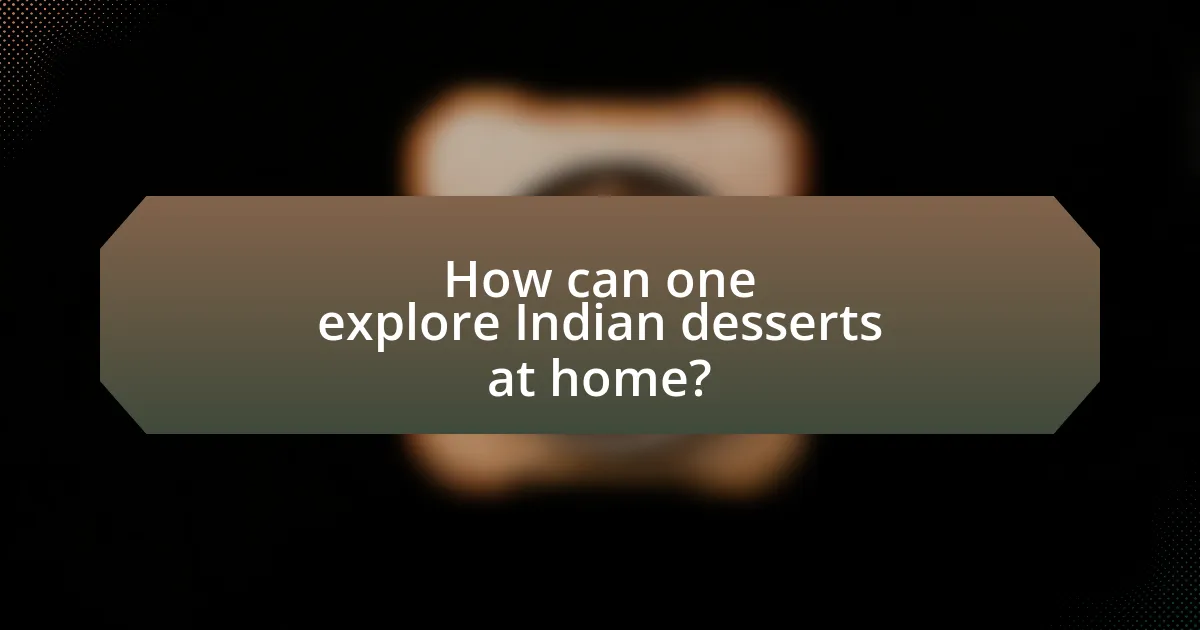The article “A Guide to Indian Desserts: Sweet Diversity Across Regions” explores the rich and varied landscape of Indian desserts, highlighting their key characteristics, regional variations, and cultural significance. It details the essential ingredients and preparation methods unique to different regions, such as the use of khoya in North India and jaggery in the West. The article also examines how festivals influence the popularity and consumption of desserts, showcasing traditional sweets associated with major celebrations. Additionally, it provides insights into popular dessert types, easy recipes for beginners, and tips for enhancing the dessert-making experience while adapting traditional recipes for modern tastes.

What are the key characteristics of Indian desserts?
Indian desserts are characterized by their rich flavors, diverse ingredients, and regional variations. They often incorporate dairy products like milk, khoya, and paneer, which contribute to their creamy texture. Common sweeteners include sugar, jaggery, and honey, enhancing the overall sweetness. Spices such as cardamom, saffron, and nutmeg are frequently used to add depth and aroma. Additionally, Indian desserts often feature nuts and dried fruits, providing a crunchy contrast to the soft textures. The preparation methods vary widely, from frying to steaming, reflecting the culinary traditions of different regions. For instance, desserts like Gulab Jamun and Jalebi are popular in North India, while Payasam and Mysore Pak are favored in the South.
How do regional variations influence Indian desserts?
Regional variations significantly influence Indian desserts by incorporating local ingredients, flavors, and cultural practices. For instance, in the northern regions, desserts like Gulab Jamun and Jalebi are popular, often utilizing khoya (reduced milk) and sugar syrup, reflecting the dairy-rich agriculture of the area. In contrast, southern states favor rice-based sweets such as Payasam, which highlight the abundance of rice and coconut. Additionally, the use of jaggery in desserts from the west, like Puran Poli, showcases the region’s sugarcane production. These regional specialties not only represent local tastes but also preserve traditional cooking methods and seasonal ingredients, illustrating the diverse culinary landscape of India.
What are the unique ingredients used in different regions?
Unique ingredients used in different regions of India include jaggery in the West, rice flour in the South, and khoya in the North. Jaggery, a traditional unrefined sugar, is commonly used in desserts like Gur ka Halwa in Maharashtra. Rice flour is a staple in South Indian sweets such as Puttu and Payasam, reflecting the region’s rice cultivation. Khoya, made from reduced milk, is essential in North Indian desserts like Gulab Jamun and Barfi, showcasing the dairy-rich culture of the area. These ingredients highlight the diverse culinary practices across India’s regions, influenced by local agriculture and traditions.
How do cultural traditions shape dessert recipes across India?
Cultural traditions significantly shape dessert recipes across India by influencing ingredients, preparation methods, and presentation styles. Each region’s unique customs, festivals, and historical influences dictate the types of desserts that are popular and how they are made. For instance, in Maharashtra, the festival of Ganesh Chaturthi features modaks, which are sweet dumplings filled with coconut and jaggery, reflecting local agricultural practices and religious significance. Similarly, in Bengal, the use of chhena (fresh cheese) in sweets like rasgulla and sandesh showcases the region’s dairy farming heritage and culinary techniques. These examples illustrate how cultural practices and local resources directly inform the diversity and richness of Indian desserts.
What role do festivals play in the popularity of Indian desserts?
Festivals significantly enhance the popularity of Indian desserts by creating occasions for their preparation and consumption. During festivals such as Diwali, Holi, and Eid, traditional sweets like Gulab Jamun, Jalebi, and Kheer are integral to celebrations, symbolizing joy and togetherness. The cultural importance of these desserts is reinforced by their association with rituals and offerings, making them essential during festive gatherings. Additionally, the increased demand for these sweets during festivals leads to a surge in their production and innovation, further embedding them in the culinary landscape of India.
Which desserts are traditionally associated with major Indian festivals?
Traditional Indian festivals are associated with a variety of desserts, including Gulab Jamun, Jalebi, Barfi, and Kheer. For instance, Gulab Jamun is commonly prepared during Diwali, symbolizing joy and celebration, while Jalebi is often enjoyed during festivals like Holi for its vibrant color and sweetness. Barfi, made from condensed milk and sugar, is a staple during Eid and Diwali, representing abundance and festivity. Kheer, a rice pudding, is traditionally made during festivals such as Pongal and Raksha Bandhan, signifying prosperity and familial bonds. These desserts not only enhance the festive spirit but also reflect the rich culinary heritage of India.
How do celebrations impact the preparation and consumption of desserts?
Celebrations significantly influence the preparation and consumption of desserts by dictating the types of sweets made and the quantity consumed. During festivals such as Diwali or Eid, traditional desserts like gulab jamun or baklava are prepared in larger quantities to accommodate gatherings, reflecting cultural significance and communal sharing. For instance, a study by the Indian Journal of Traditional Knowledge highlights that specific desserts are associated with particular celebrations, reinforcing cultural identity and heritage. This connection between celebrations and desserts enhances the overall experience, making sweets an integral part of the festivities.

What are some popular types of Indian desserts?
Some popular types of Indian desserts include Gulab Jamun, Jalebi, Rasgulla, Kheer, and Barfi. Gulab Jamun consists of deep-fried dough balls soaked in sugar syrup, while Jalebi is made from fermented batter fried into spiral shapes and dipped in syrup. Rasgulla is a spongy cheese ball soaked in sugar syrup, Kheer is a rice pudding made with milk and sugar, and Barfi is a fudge-like sweet made from condensed milk and various flavorings. These desserts are integral to Indian cuisine and are often served during festivals and celebrations, showcasing the rich diversity of flavors and textures across different regions of India.
What are the most famous milk-based Indian desserts?
The most famous milk-based Indian desserts include Gulab Jamun, Rasgulla, Kheer, and Barfi. Gulab Jamun consists of deep-fried dough balls soaked in sugar syrup, originating from Persian influences in Indian cuisine. Rasgulla is a spongy dessert made from chhena (fresh cheese) and cooked in light syrup, primarily associated with Bengali cuisine. Kheer is a rice pudding made with milk, sugar, and flavored with cardamom, often garnished with nuts, and is popular across various regions. Barfi is a fudge-like sweet made from condensed milk and sugar, often flavored with fruits or nuts, and is widely enjoyed during festivals. These desserts are celebrated for their rich flavors and cultural significance in Indian culinary traditions.
How is Gulab Jamun prepared and served?
Gulab Jamun is prepared by making a dough from khoya (reduced milk), flour, and a leavening agent, which is then shaped into small balls. These balls are deep-fried in ghee until golden brown and soaked in a sugar syrup flavored with cardamom and rose water. The frying process typically takes about 5-7 minutes per batch, ensuring they are cooked evenly. Once soaked in the syrup for at least 30 minutes, Gulab Jamun is served warm or at room temperature, often garnished with nuts like pistachios or almonds. This traditional dessert is popular across India and is commonly served during festivals and celebrations.
What makes Rasgulla a beloved dessert in India?
Rasgulla is a beloved dessert in India primarily due to its unique texture and delightful sweetness. This spongy, syrup-soaked treat is made from chhena (fresh cheese) and is known for its lightness and melt-in-the-mouth quality. The dessert’s origins trace back to the state of West Bengal, where it has become an integral part of the culture and culinary heritage. Rasgulla’s popularity is further evidenced by its recognition as a Geographical Indication (GI) product, which highlights its significance and authenticity in Indian cuisine. The combination of its rich history, cultural importance, and appealing taste contributes to Rasgulla’s status as a cherished dessert across the country.
What are the traditional flour-based Indian desserts?
Traditional flour-based Indian desserts include items such as Gulab Jamun, Jalebi, and Barfi. Gulab Jamun is made from khoya (reduced milk) and flour, deep-fried, and soaked in sugar syrup. Jalebi consists of fermented flour batter, shaped into spirals, fried, and then dipped in sugar syrup. Barfi is often made from a mixture of flour, sugar, and various flavorings, cooked until it reaches a fudge-like consistency. These desserts are integral to Indian cuisine, showcasing regional variations and cultural significance, often served during festivals and celebrations.
How is Jalebi made and what is its significance?
Jalebi is made by fermenting a batter of all-purpose flour and water, which is then piped into hot oil in a circular shape to create spiral shapes. After frying, the jalebi is soaked in a sugar syrup flavored with cardamom and saffron, giving it a sweet and aromatic taste. The significance of jalebi lies in its cultural importance in Indian festivals and celebrations, symbolizing joy and festivity, and it is often served during weddings and religious occasions, reflecting the rich culinary heritage of India.
What variations of Ladoo exist across different regions?
Ladoo variations across different regions of India include Besan Ladoo from Maharashtra, made with gram flour and ghee; Motichoor Ladoo from Uttar Pradesh, consisting of tiny fried gram flour balls soaked in sugar syrup; and Rava Ladoo from South India, prepared using semolina, coconut, and jaggery. Each type reflects local ingredients and culinary traditions, showcasing the diversity of Indian sweets. For instance, Besan Ladoo is often prepared during festivals like Diwali, while Motichoor Ladoo is a popular offering during weddings and celebrations.

How can one explore Indian desserts at home?
To explore Indian desserts at home, one can start by researching traditional recipes from various regions of India, such as Gulab Jamun from North India, Rasgulla from West Bengal, and Payasam from South India. Utilizing online resources, cookbooks, and food blogs dedicated to Indian cuisine can provide authentic recipes and preparation methods. Additionally, sourcing ingredients like jaggery, cardamom, and various flours from local Indian grocery stores or online markets is essential for authenticity. Engaging in cooking classes, either virtually or in-person, can also enhance the understanding of techniques and cultural significance behind these desserts.
What are some easy recipes for beginners to try?
Some easy recipes for beginners to try include Kheer, a rice pudding made with milk, sugar, and rice, which is simple to prepare and requires minimal ingredients. Another beginner-friendly recipe is Gulab Jamun, which involves making dough balls from milk solids, frying them, and soaking them in sugar syrup. Additionally, Rava Ladoo, made from semolina, sugar, and ghee, is straightforward and requires no advanced cooking techniques. These recipes are popular in Indian cuisine and are often recommended for novice cooks due to their simplicity and the common availability of ingredients.
How can one make a simple Kheer at home?
To make a simple Kheer at home, one needs to boil milk and add rice, sugar, and cardamom. Begin by boiling 1 liter of full-fat milk in a heavy-bottomed pan. Once the milk starts to boil, add 1/4 cup of rinsed basmati rice and cook on low heat, stirring occasionally, until the rice is soft and the milk thickens, which takes about 30-40 minutes. Then, add 1/2 cup of sugar and 1/2 teaspoon of cardamom powder, mixing well until the sugar dissolves. For added flavor, one can garnish with chopped nuts like almonds or pistachios. This method is a traditional approach to preparing Kheer, a popular Indian dessert known for its creamy texture and sweet taste.
What ingredients are essential for preparing basic Indian sweets?
Essential ingredients for preparing basic Indian sweets include milk, sugar, and various types of flour such as chickpea flour or rice flour. Milk serves as a primary base for many sweets, providing creaminess and richness, while sugar is crucial for sweetness. Flour types contribute to texture and structure; for example, chickpea flour is used in making besan ladoo, and rice flour is essential for making modak. These ingredients are foundational in traditional recipes, ensuring authenticity and flavor in Indian desserts.
What tips can enhance the experience of making Indian desserts?
To enhance the experience of making Indian desserts, focus on using high-quality ingredients, as they significantly impact flavor and texture. Freshly ground spices, pure ghee, and authentic sweeteners like jaggery or khoya elevate the overall quality of the dessert. Additionally, mastering traditional techniques, such as slow cooking and proper tempering, ensures that the flavors meld beautifully. For instance, making gulab jamun requires precise frying and soaking in syrup to achieve the perfect consistency. Lastly, experimenting with regional variations can introduce unique flavors and textures, enriching the dessert-making experience.
How can one adapt traditional recipes for modern tastes?
One can adapt traditional recipes for modern tastes by incorporating healthier ingredients, reducing sugar, and experimenting with flavors. For instance, traditional Indian desserts like gulab jamun can be made using whole wheat flour instead of refined flour, and natural sweeteners like jaggery or honey can replace refined sugar. Additionally, introducing contemporary flavors such as matcha or coconut can modernize the taste profile while maintaining the essence of the original recipe. This approach aligns with current dietary trends that favor health-conscious choices, as evidenced by a growing consumer preference for desserts that are lower in calories and sugar, yet still satisfying.
What common mistakes should be avoided when preparing Indian desserts?
Common mistakes to avoid when preparing Indian desserts include improper measurement of ingredients, which can lead to inconsistent textures and flavors. Accurate measurements are crucial, as Indian desserts often rely on precise ratios of sugar, flour, and other components to achieve the desired outcome. Another mistake is neglecting to use fresh ingredients; stale or expired items can significantly affect the taste and quality of the dessert. Additionally, failing to follow cooking times and temperatures can result in undercooked or burnt desserts, compromising their overall appeal. Lastly, not allowing desserts to cool properly before serving can alter their texture and presentation, diminishing the dining experience.
